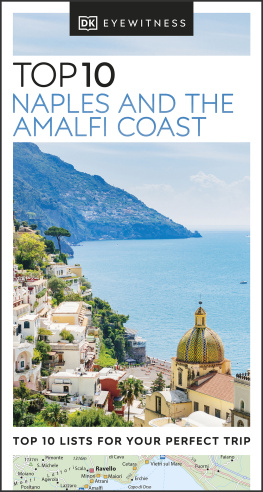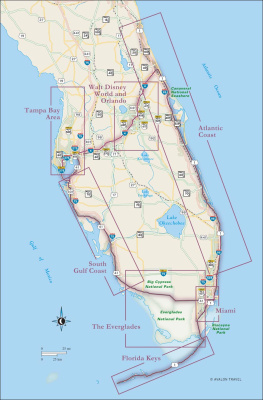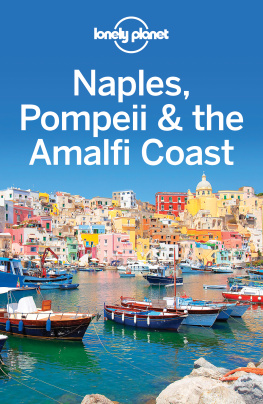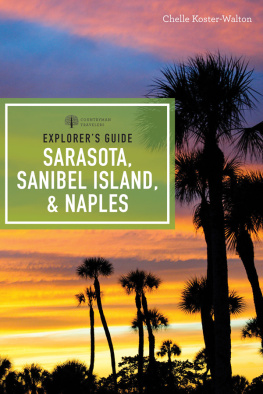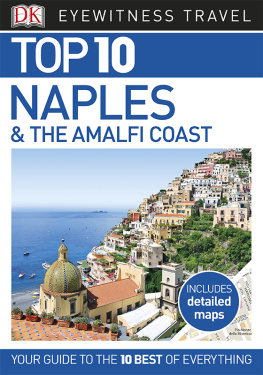Acknowledgments
This book would not have been possible without the indulgence and infinite patience of my beautiful wife. Id also like to thank my kids for accompanying me on several of the mini-vacations we took under the guise of research trips; with them along for the ride, it seemed a whole lot less like work. Additionally, my friends Soraya and Summer were invaluable with their assistance in the exhaustiveand exhaustingwork of compiling and confirming the facts and figures at the heart of the book.
There are three formal geographical regions in the state of Florida, two of which make their way in some fashion to the areas covered in this book. The Atlantic Coastal Plain extends all the way north to Cape Cod, Massachusetts and encompasses the entirety of Floridas east coast. Its an area defined by low, flat topography and features like sandy beaches, scrub-flecked ranchlands, the swamps of the Everglades and Big Cypress, and the marshy wetlands of central Florida. This region of the state connects seamlessly to the East Gulf Coastal Plain that runs along Floridas west coast. In the south central part of the state, this region shares the swampy characteristics of the Glades and Big Cypress; however, the Gulf beaches see far less wave action from the gentle Gulf of Mexico, resulting in powdery, white-sand beaches that are quite legendary. In the Panhandle is the third distinct and formal geographic region, the Florida Uplands, which resemble the pine forest landscapes of the American South and are home to what little elevation the state has to offer.
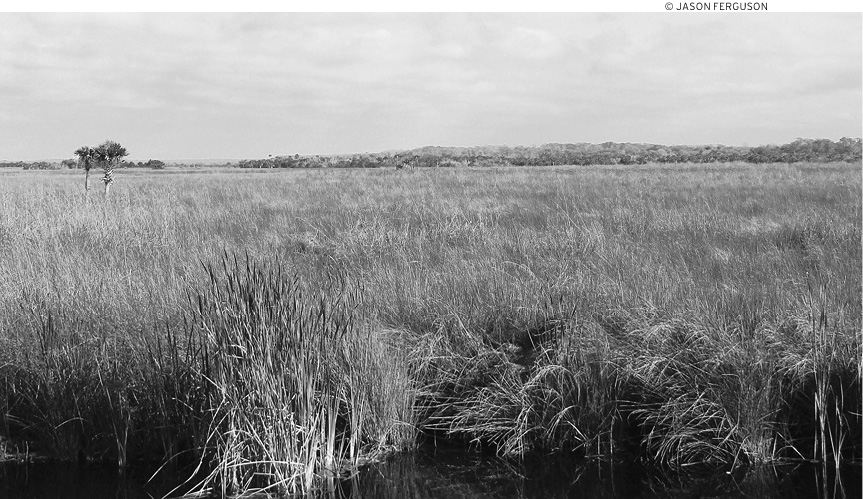
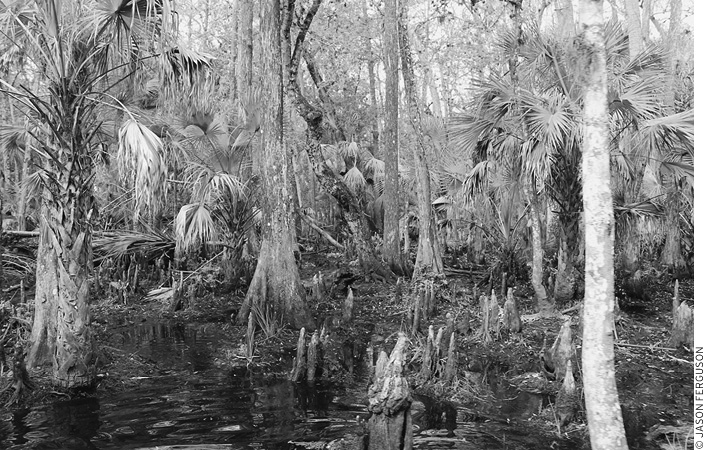
Swamps are just one ecosystem found in southwest Florida.
This part of Florida really only sees two seasons: oppressive and pleasant. Summer lasts a little longer in south Florida (mid-March to mid-October) and has a tendency to be dizzyingly humid and hot with daily thundershowers. But as a reward for sweating it out for half the year, south Floridians enjoy a picture-perfect other half, with an autumn/winter/spring season that sees consistent sunny, warm, and dry days with highs in the mid-70s to low 80s and lows clicking in comfortably around 60 every night. Though some nights can get a little chilly and there are a handful of days when a light jacket might be necessary to ward off a cool, mid-50s breeze, south Floridas weather between Halloween and Valentines Day is about as perfect as one could hope for.
Floridas environmental issues can be distilled into one simple word: growth. With a relatively young history that has most of its roots in the states development as a tourist destination, Floridas complex and beautiful ecology has been the victim of unplanned and unchecked development throughout the last century, and until very recently, environmental concerns took a very distant backseat to the demands of real estate speculators, construction interests, and the tourism industry. Entire portions of the states most singular ecological treasure, the Everglades, were drained, dredged, and built upon to satisfy the expansion of south Floridas suburbs and the needs of the mighty sugar industry. Coastal development has demolished dunes, and even the seemingly inhospitable Palmetto Prairie in the south-central portion of the state is beginning to experience the beginnings of far-flung suburban residential developments.
Beyond the impact of development on the states ecology, the fast-growing state has spread out in all directions, resulting in low-density cities surrounded by dozens of commuter towns. The net effect is a deeply entrenched car culture and endless miles of roadways surrounded by cookie-cutter subdivisions that eat into land that was previously agricultural or undisturbed homes for wildlife. While there are still great swathes of untamed land in Florida, those areas are slowly being eroded by development.
HURRICANES
The official season for Atlantic hurricanes is June 1 through November 1, but the peak of activity is usually in August and September. The Florida Keys and south Florida are most often in the direct path of the storms that form in the Atlantic basin. Although almost every region of Florida has been impacted by a hurricane, most notably in 2004, when an unprecedented four hurricanes hit the state, including three that crossed the normally untouched central Florida region, its the Keys and south Florida that generally assume theyll be hit. And for good reason: Florida is a hurricane magnet and when the storms do hit, they hit quite hard. The city of Punta Gorda was almost completely leveled when the 2004 storms hit.
If there is a hurricane warning announced for the area youre vacationing in, you need to leave immediately. Dont let nay-saying locals sway your decision with talk about how it wasnt so bad the last time or itll curve away like they always do. The terror of 70 mph (or higher) winds is an entirely different experience when youre not watching it on the Weather Channel, and even storms with mid-range winds can often bring flooding downpours that are incredibly dangerous. Despite their best efforts, hurricane trackers are usually wrong, or at least not completely right, and these storms are large and unpredictable. Dont be a hero, dont be a know-it-all, dont be brave. Just leave. The state will (hopefully) still be here when you come back.
To the surprise of many, southwest Florida isnt just home to swaying palm trees and orange groves. Scrub pines and slash pines are common throughout the regions midsection. Along the coastline, mangroves are quite prevalent and black mangroves can soar up to 50 feet in height. Some unique native Florida trees include west Indian mahogany trees, which can be found in southern Florida and the Keys, and pond apple trees that grow in the states swamps. Of course, the state is most commonly identified with palm trees, but the massive coconut palms that indicate tropical vacation to so many people are, though common throughout the state, not a native tree. The true Florida palms are the equally tall sabal palm trees. Cypress trees abound in the swampy areas of the state.
The official flower of Florida is the orange blossom. For the early part of the 20th century, a drive through the orange groves of central and southern Florida as the fragrant flowers bloomed was one of the high points of a vacation to the state. Of course, the tropical and subtropical climate means an abundance of gorgeous flowering plants can be seen almost year-round. Invasive species like bougainvillea, jasmine, gardenias, birds of paradise, and oleander have taken their place alongside native beauties like mistletoe and the puffy-flowered sweet acacia to make the state one of the most beautifully and naturally landscaped parts of the country. Note: Though somewhat common throughout the Everglades, wild orchids cannot be collected as theyre protected by law.
MANATEE PRESERVATION
As they like to inhabit the same waters that Floridas many boaters enjoy recreating on, manatees face their single biggest threat from the propeller blades of fast-moving boats. Injuries sustained by contact with boats have resulted in thousands of manatees dying in a most gruesome fashion. Even manatees that arent struck by a boats propeller have been threatened by the deleterious effects of fishing gear (nets, hooks, etc.) that they swallow while feeding on sea grasses and algae.








